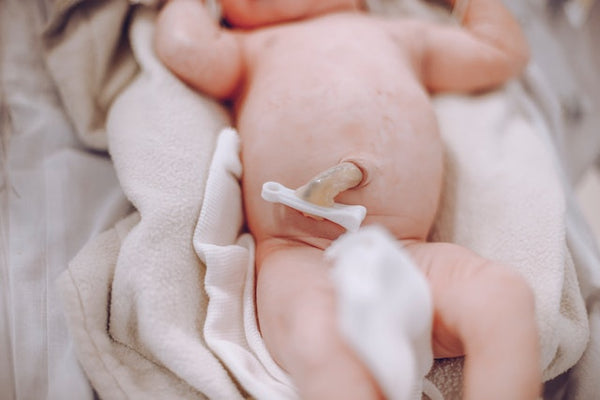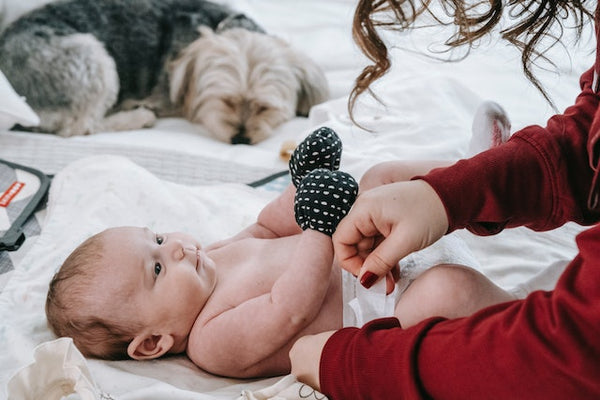What You Need to Know About Umbilical Granuloma in Newborns

Updated 29 Dec 2024
When your newborn baby's umbilical cord stump dries up and falls off, you might notice a cute belly button. Usually, a small raw area is left behind, which is normal and heals quickly, like a scab. However, there's a lesser-known issue called an umbilical granuloma. This is when a small lump of tissue forms inside the belly button because of scar tissue. While it doesn't hurt your baby, it could lead to infection. If this happens, a doctor should treat it to keep your baby safe and healthy. Let’s take a closer look at umbilical cord care and what to do if you think your newborn has developed an umbilical granuloma.
Umbilical Cord Care Basics
You don't need to do much to help your baby's umbilical cord heal. Just keep the area around it clean and dry. The doctor will check it during your baby's checkups to ensure it's not infected. Until the cord falls off, avoid fully submerging your baby in a deep bath or putting their belly button in water. Instead, use a little tub or sink to gently clean your baby's skin with warm, soapy water and a washcloth. Be careful not to get the cord too wet. After cleaning, dry your baby gently, including their belly button. If the diaper rubs against the belly button, fold it down so it doesn't cause friction.
Usually, the cord will fall off by itself within one to three weeks after birth. If it's still there after three weeks, tell the doctor. Sometimes, it might fall off earlier, which is okay if it wasn't removed intentionally.
OXO Tot Splash & Store Bathtub was created to grow with little ones from birth – 18 months. The carefully engineered design has a narrow end for cradling newborns and smaller infants – eliminating the need for a separate infant insert. The wider end is perfect for babies who can sit up on their own, giving them plenty of space to splash. The built-in support post keeps babies safely in place, no matter their age or stage. The quick-release, dual-sided drain is easy for grown-ups to access, even with baby in the Tub. All clean? The tub collapses flat for compact storage; the 360° swiveling hook hangs from shower heads or rods for quick drying.

OXO Tot Splash & Store Bathtub
What Is Umbilical Granuloma in Newborns?
An umbilical pyogenic granuloma is a normal and harmless issue that can happen in newborns. It’s not something they’re born with but usually appears a few weeks after birth. It's caused by extra tissue growing around the belly button after the umbilical cord falls off. An umbilical granuloma will appear as a tiny, wet, pink or red ball. It might have a thin layer of yellow or white on top, release light-colored fluid, or seem pink and swollen around its edges.
According to the American Pediatric Surgical Association (APSA), around 1 in every 500 newborns has a chance of developing an umbilical granuloma. After your baby's cord falls off, it's normal to initially see a small red spot or lump of tissue. However, if your baby's belly button isn't fully healed after two weeks, or if you notice new tissue growing, get in touch with the doctor for the next steps.
What Causes Umbilical Granulomas?
Doctors don't yet understand why some newborns get granulomas while others don't. It's not caused by genes or the environment, and there’s not any proof that not taking care of the umbilical cord properly after birth leads to granulomas. It might be a bit more common in babies whose cords take longer than usual to fall off, but doctors are not certain.
How Do You Get Rid of Umbilical Granuloma?
In many situations, your child's doctor will treat your baby's granuloma using a chemical called silver nitrate. When a tiny bit of this is applied to the granuloma, it makes the tissue stop growing and eventually become smaller. Don't worry – this doesn't hurt your baby. (The granuloma tissue doesn't have nerve endings.) If this method doesn't work, there are other ways to treat it:
- The doctor can freeze off the granuloma using a little bit of very cold liquid nitrogen.
- The doctor can tie a special thread around the base of the granuloma to cut off its blood supply. This makes it dry up.
None of these procedures cause pain for your baby. In some rare cases, surgery might be needed to remove the granuloma, but most of the time, simple methods done at the doctor's office can take care of it.

What Are Some Other Umbilical Cord Issues I Should Know About?
Always watch out for signs of infection in your baby's belly button. According to the American Academy of Pediatrics (AAP), an infected belly button might:
- Give off a bad smell
- Make the skin around it look very red, swollen, or streaked with red
- Cause a fever or make your baby fussy
- Leak yellow fluid or pus
- Make your baby uncomfortable when you touch it
Another common problem with the umbilical cord is an umbilical hernia. The American Pediatric Surgical Association (APSA) says that about 20% of babies have this issue. It happens when the muscles around the belly button aren't fully connected, so a bit of tissue can bulge out through it. This often shows up more when the baby is crying. Just like granulomas, hernias don't hurt your baby. Even though umbilical hernias might sound scary, the AAP says most heal by themselves without needing help by the time a child is 18 months old. If not, a simple surgery might be needed when the child is older, usually around 5 years old.
When Should I Contact My Pediatrician?
Most problems with the umbilical cord are not bad or painful for your baby. However, if your baby's umbilical cord doesn't heal as it should, you should tell your doctor. This could mean it hasn't fallen off within the first month after birth, there's a growth of tissue left for more than two weeks, or it seems infected at any point.
The Takeaway on Umbilical Granuloma in Newborns
While it might be worrying to see your child having an umbilical granuloma, you can rest easy knowing that it doesn't hurt your baby and isn't harmful. Most of them can be handled by a doctor without much trouble. Soon enough, your child's belly button will be all set for gentle baths and lots of playful moments.
Disclaimer: The information on our site is NOT medical advice for any specific person or condition. It is only meant as general information. Please contact your health provider if you have any medical questions or concerns about your child or yourself.









